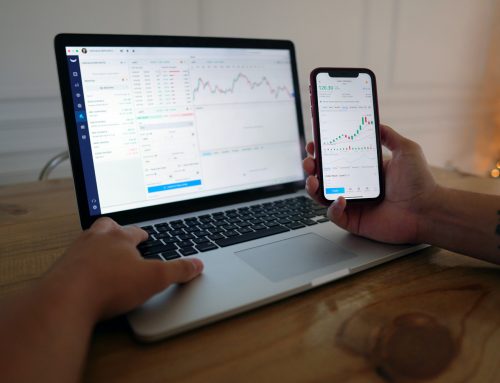Getting started investing can be daunting. Even if you’ve invested time and energy into learning technical analysis and learning fundamental analysis, actually using these newfound skills in real-time scenarios is stressful.
The fear of losses often overshadows the thrill of potential gains. So, you end up stuck in what is called analysis paralysis – never actually putting your abilities to the test. Or, worse – you dive right into live trading scenarios and watch your account blow up within a few weeks.
Enter the realm of paper trading – your risk-free training ground.
Wait, what is paper trading, you ask?
This is essentially trading in real market conditions with fake money. It gives you a chance to simulate the trading environment without the stress and concern of losing trades.
We’ll cover everything you need to know about this technique and help you harness its potential to feel confident and capable of navigating real trading scenarios in the future.
And, we’ll show you how you can get started paper trading with VectorVest, the stock picking software that’s outperformed the S&P 500 index by 10x over the past 20 years and counting!
What is Paper Trading?
So, what is paper trading? This is an essential stepping stone in the world of investing. It’s a simulated trading process where would-be investors can practice buying and selling securities without risking actual capital.
How Does Paper Trading Work?
Traders use real market data to make trades, but instead of actual money changing hands, these transactions occur purely on paper or, more commonly now, within a simulated trading platform.
The prices and outcomes are real, but the money is not, providing a safe platform for experimentation and learning. You can typically paper trade within the best swing trading platforms, like VectorVest or TD Ameritrade ThinkorSwim.
Paper trading effectively bridges the gap between theoretical knowledge and practical application. It allows traders to apply what they’ve learned about markets, economics, and trading psychology in a tangible, yet forgiving, environment.
Can You Make Real Money From Paper Trading?
Sadly, no – alchemy still does not exist. You cannot make real money without putting real money on the line in a legitimate trading scenario.
Still, this hands-on approach is invaluable for building confidence and competence before transitioning to live trading. That being said, let’s take a deeper look at the benefits of paper trading.
What is Paper Trading Used For?
Now, what is paper trading used for? There are a few reasons to add this technique to your arsenal whether you’re a brand-new trader looking to get started with swing trading for beginners or you want to implement more advanced market timing strategies as a seasoned investor.
Developing Trading Skills Without Financial Risk
The primary purpose of paper trading is to allow traders to gain practical experience without the risk of losing real money. This aspect is particularly beneficial for beginners, who can learn the ropes of trading in a simulated, stress-free environment.
- Understanding Market Dynamics: Paper trading helps traders understand how markets react to various global events, news, and economic changes. This hands-on experience is invaluable in building a foundational understanding of market behavior.
- Learning Trading Platforms: It offers an opportunity to navigate and understand trading platforms. Traders can familiarize themselves with order types, market indicators, and other tools without the pressure of real capital at stake.
- Building Confidence: By practicing in a risk-free environment, traders can build confidence in their decision-making skills. This confidence is crucial when transitioning to real-money trading.
For example, say you read our guide on stock technical indicators – and now you want to try and execute trades using the best EMA for swing trading or some other indicator for swing trading. You can put these skills to the test and make mistakes without any real risk.
Testing and Refining Trading Strategies
Another critical use of paper trading is in the testing and refinement of trading strategies. Maybe you’re already an advanced swing trader or day trader – but now, you want to try position trading. Or, maybe you typically trade stocks but want to dabble in swing trading options.
You can also use paper trading to understand and apply risk management principles. You’re able to learn how to mitigate risks effectively by experimenting with stop-loss orders and portfolio diversification in a simulated environment.
Plus, paper trading platforms often provide detailed analyses of trades. This data can be used to understand what strategies are working, which aren’t, and why. Such insights are vital for refining trading methods and improving overall performance.
What are the Risks of Paper Trading?
While paper trading is an invaluable tool for honing trading skills without financial risk, it’s not without its pitfalls. One primary risk is the potential of getting too comfortable in the practice phase.
This comfort zone can lead to a hesitation to transition to real trading, where actual capital is at risk. It’s essential to remember that the ultimate goal of paper trading is to prepare you for the real market.
Another risk is the development of complacency. Since paper trading doesn’t involve real money, there’s a temptation to take unrealistic risks or not take the practice seriously.
This attitude can lead to the formation of bad trading habits that could be detrimental when applied in real-world trading. It’s crucial to treat paper trading as seriously as real trading, making decisions as if real money were at stake.
Tips on Getting Started With Paper Trading
Ready to get started practicing with paper trading? As we said earlier, there’s a good chance the platform you use to analyze and execute trades accommodates this method of trading.
If not, don’t worry – VectorVest does! This is just one of many reasons our stock advisory is one of the most trusted choices online. That being said, let’s start with a quick overview of choosing the right platform.
What to Look For When Choosing the Right Platform
The platform should mirror the live market as closely as possible. Real-time or near-real-time data is essential to simulate an authentic trading experience.
Look for platforms offering comprehensive charting tools essential for swing traders. This includes the ability to plot and analyze key swing trading indicators such as moving averages (e.g., 50-day, 200-day), Bollinger Bands, MACD, and RSI.
The capability to customize time frames from days to weeks is also vital. Learn more about the importance of using the best time frame for swing trading to find swing trading patterns in our blog.
The best paper trading platforms for swing traders will offer access to historical market data, too. This allows you to simulate swing trades in past market conditions, testing your strategies against real historical scenarios.
Similarly, you should look for a platform that allows you the ability to set up and receive alerts based on specific swing trading criteria like price breakouts or technical indicator thresholds.
Swing trading tools that help you practice risk management strategies are key as well. Look for features that allow you to set stop-loss orders, take-profit levels, and practice portfolio diversification aligned with swing trading practices. This helps you figure out when to sell stocks at a loss and get in the habit of cutting losses when necessary.
It’s also important that you have access to detailed performance tracking and reporting features. This should include the ability to analyze the performance of your swing trading strategies over time, trade win/loss ratios, and other KPIs.
Don’t worry – we’ll introduce you to the best stock analysis app that accommodates all this and more in a moment. For now, let’s talk about actually doing paper trading.
Setting Realistic Trading Goals and Scenarios
Just like figuring out realistic swing trading returns in real trading, setting goals in paper trading is vital. It’s not just about making hypothetical money – it’s about learning.
Are you trying to understand the stock market, or are you testing a specific trading strategy? Your goals will guide your trading decisions.
Even though it is simulated, you should behave as if you’re trading with real money. If not, what’s the point? This means considering the size of your portfolio, the risk you’re willing to take, and realistic order sizes.
Don’t stick to one market condition. Try trading in different scenarios – bullish, bearish, volatile markets – to get a well-rounded experience. This prepares you for both buying the dip and investing in a down market alike.
Tracking and Analyzing Your Paper Trades
Tracking and analyzing your trades is where the real learning happens. Document every trade – why you made it, what the outcome was, what you learned. It’s an invaluable tool for reflection and learning.
This helps you figure out what’s working, what’s not, and where you can improve. Maybe you’re getting into trades too late and need a way of predicting market trends earlier. Or, maybe you’re not selling fast enough and you’re missing your window for profit. Either way, use this information to refine your strategies.
When to Stop Paper Trading and Start Trading With Real Capital
Knowing when to transition from paper trading to real trading can be tricky. But eventually, you’ll need to take the leap of faith into real trading. How can you tell when you’re ready, though?
If you’ve been consistently successful in your paper trades over a significant period and you feel as if you’ve got a good grasp on the swing trading basics, it might be time to consider real trading. But if you’re losing trades on a regular basis, your stock picking strategy or portfolio management may need work still.
You should also ask yourself how you feel. Are you confident in your trading strategy? Do you feel comfortable making and executing trading decisions? Be honest with yourself, and don’t be afraid to put your ego aside and admit you need more guidance.
Even when you move to real trading, start small. Don’t jump in with all your capital at once. We have a guide on trading with a small account if you’d like to learn more. At this point, though, it’s time to get started paper trading with VectorVest!
Practice Paper Trading in VectorVest Today and Transform Your Trading Strategy For the Better!
VectorVest is an intuitive, innovative way to analyze stocks and uncover the best stocks for swing trading, best stocks for day trading, best starter stocks, or any other opportunities for that matter!
It’s all based on a proprietary trading algorithm that consolidates key insights into simple, easy-to-understand ratings – empowering you to win more trades with less work. You’re given everything from a market timing indicator to market sentiment indicator.
But, the best part is that you’re actually given a clear buy, sell, or hold recommendation for any given stock at any given time. No more guesswork and uncertainty clouding your judgment or costing you profits!
You don’t just get help selecting stocks for swing trading, though. You’re also told when to buy stocks and when to sell them, making position management easier and more straightforward than ever. And, the system supports paper trading!
That means you can learn swing trading through the VectorVest system and put your skills to the test in real-time. This is your risk-free playground where you can apply the strategies you’ve honed using our tools, test your ideas, and build confidence without the financial risk.
It’s an ideal blend of learning and application, ensuring that when you’re ready to trade with real capital, you’re doing so with a strategy that’s been tried, tested, and perfected. Learn more and see how the system works through a free stock analysis today!
Wrapping Up Our Beginner’s Guide to Paper Trading
So, what is paper trading? As we draw this beginner’s guide to a close we want to remind you that this technique helps you build confidence, hone skills, and master strategies in a safe, risk-free environment. You can leverage simulated trading situations so that when real money is on the line, you’re prepared for anything.
Discover other tips for swing trading in our blog, such as the best time of day to buy stocks, what is a swing trade, scalping vs swing trading, is swing trading profitable, the difference between fundamental analysis and technical analysis, benefits of swing trading, timing the market vs time in the market, and more.
Embrace the power of informed, strategic trading with VectorVest. Invest in yourself, harness the potential of paper trading, and save yourself time & stress with a more foolproof approach to investing!








Leave A Comment